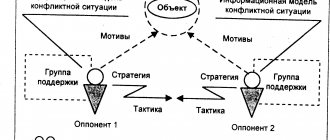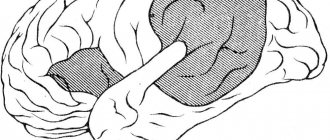Causes of the crisis
The period itself, when a child just starts school, is characterized by some features. A newly minted student is forced to quickly adapt to new requirements, conditions, surroundings, and he has a new level of responsibility. The child has to get used to discipline and intellectual stress. And communication in a new team does not always bring only pleasant impressions. At the same time, relationships with family members change. All this cannot but affect the child, and a crisis period begins, which is based on denial.
Firstly, the first-grader loses his childish spontaneity . This concept includes sincerity, ingenuousness and the ability to act according to the situation, without doubts and long thoughts. Now the child’s behavior depends more and more on his will, and external factors influence him less and less. Many children become mannered and make faces. You can also notice pretense in behavior.
The fact is that the child chooses a certain position for himself and obeys its logic. At the same time, he does not care that the role he has chosen may be completely inappropriate here and now. From the outside it looks strange: the child’s mood is like a roller coaster for no apparent reason, and reactions to what is happening look unnatural, behavior changes.
Secondly, a contradiction arises between the environment and the child's needs . Between the ages of 6 and 8, boys and girls desperately want to become adults. And it’s not only about internal necessity, but also about the influence of family and society. After all, everyone around is just saying: “What, have you already gone to school? Oh, you’re so grown up already!”
In this case, it is quite natural that, having started going to 1st grade, the child realizes the importance of the moment associated with the change in his social status. Therefore, he hopes that now he has definitely become an adult and independent. And if so, it means that he can make his own decisions and manage his life. This explains the desire to change the way of life and the old rules that were in force before he entered school. The little rebel wants to choose for himself what to wear, what time to go to bed, where to go, when to have lunch. He believes that he has grown up and that he has every right to do so.
Cognitive processes
Perception
- By studying objects and using them, the child begins to understand their qualities, their color, shape, material, weight, etc.
- When he perceives speech, he perceives differences in the pronunciation of sounds.
- When he perceives music, he begins to grasp the rhythm and pitch of sounds.
- The child learns to navigate space, restore the sequence of events, and remember the location of objects.
- A preschooler perceives the world around him more accurately because he begins to study the properties of individual phenomena and objects.
Attention
Preschoolers' memory begins to actively develop; they can study pictures and listen to fairy tales for a long time.
The child's attention is organized mainly by speech. Initially, adults draw the child’s attention to something with the help of words, then the child himself uses words to indicate what he wants to draw someone’s attention to. Thus, everything that occupies the child is expressed verbally.
Thinking
By playing with an object that replaces something, the child learns to imagine the real thing. Gradually, this leads to the fact that the baby can independently imagine some objects, his actions and actions in his mind. This, in turn, further allows you to predict people’s assessments and plan your behavior in accordance with the expected reactions of others.
Memory
The child needs communication. This helps him learn to remember and be attentive. If a child does not follow the rules of the game, is not focused on them, and cannot remember his role, then his peers will not want to play with him.
A preschool child remembers best involuntarily. That is, not when he specifically peers for a long time and intensely at the picture in order to remember its details. And, for example, when it selects pictures according to certain characteristics, sorts them, determines common or different features. That is, the child’s memory is activated when he uses thinking and logic.
The baby begins to learn to repeat, reflect, systematize in order to remember. For a preschooler, memory is the main function.
Imagination
In the beginning, imagination is associated with perception and action. The girl feeds the doll. She is a mother, the doll is a daughter. Without using a doll, a girl cannot imagine herself as a mother.
Older preschoolers are already learning to control their imagination. The creative imagination is actively developing, which is influenced by the writing of stories, fairy tales, possibly poems, etc. In this way, the child expresses what he imagines, what he dreams or thinks about.
But during this period the child requires special attention and control. Because sometimes a fictional, imaginary life, which sometimes seems much better to a child than the real one, replaces reality. This suggests that the child’s psyche is distorted.
Speech
In preschoolers, vocabulary is related to what surrounds the child, how much he is taught, and how much time and attention is given to him. Individual characteristics also play a role. Speech is a means of communication, a way of expressing emotions and exchanging information.
Feelings
Older preschoolers begin to show concern, worry about the well-being of family and friends, and try to protect them from grief and problems. But the feelings of a preschooler are not at all similar to the feelings of an adult. A child’s feelings directly depend on how much love and attention he receives from his family. A child may feel shame or pride in his actions and actions, focusing on the assessments of others. He worries and worries not about his action, but about how his loved ones will react to him.
At preschool age, children begin to understand and appreciate the beauty of the world around them. They are easily impressed by the natural phenomena they see, by the music they listen to, and by the bright colors of paintings.
Before school, the child already knows how, or at least tries, to hide violent emotions (hides tears or fear). Can also detect changes in other people by facial expressions, gestures, movements, and gaze.
Behavior and will
Preschoolers are just beginning to control their behavior and their actions. Conscious control borders on impulsive and spontaneous actions.
In the preschool period, the child already recognizes and understands the norms of behavior, applies them in communication with adults and his peers. The child knows how to behave and why, and understands his responsibilities.
During this period, the child develops the habit of acting and behaving in the right way, as adults explained to him. If he breaks this habit, he feels uncomfortable and anxious. It is habit that subsequently helps to develop correct behavior, which in turn is good education.
At preschool age, the child begins to know himself and develop himself. It is natural for a child to have a positive assessment of himself. He considers himself good and this can mainly help in raising a child. In order to meet the “good” characteristic and achieve praise from adults, he will strive to become better and do good deeds.
Signs of crisis 7 years
How can parents determine that their child is going through a crisis and is not just being mischievous? This period has been well studied by specialists in the field of child psychology. They identified very specific signs that will help adults draw the right conclusions regarding the child’s condition. All that is required is to watch him carefully. So, it’s a matter of age-related difficulties, if you notice that the child:
- gets tired quickly;
- gets irritated, is often quick-tempered and aggressive (or vice versa - quiet and withdrawn, if this is not at all characteristic of him);
- became absent-minded;
- mischievous for no reason;
- cannot sit still, constantly spins;
- imitates elders, is rude, “negotiates” with them;
- often imitates adults;
- clowns around, behaves unnaturally;
- compares himself with peers, and these comparisons are usually not in his favor;
- is looking for a role model (and often chooses in this capacity a friend who does not have the best behavior and other indicators);
- fawns over adults, trying to earn approval and attract their attention;
- snitches on other children;
- stopped playing with toys that not so long ago he considered the best;
- but he really loved playing with other guys;
- stopped being interested in kindergarten and everything connected with it;
- does not want to go to developmental classes, but this problem did not exist before;
- prefers to communicate with peers and older children, and avoids younger ones;
- he likes to play school, he often asks questions on this topic;
- became very stubborn;
- conflicts with parents over trifles;
- In general, it has changed a lot over the past six months or a year.
All this indicates that the crisis has begun for 7 years. Parents should help their child. This can be done if you radically change your attitude towards it and update your requirements. Otherwise, the difficult period may drag on and lead to the appearance of undesirable character traits.
Your psychologist. The work of a psychologist at school.
By the age of 6, formation begins psychological readiness to schooling, and the formation of its prerequisites is associated with crisis 6—7 years. The identification of this crisis in the development of a child is associated with the name of L. S. Vygotsky. He noted that older preschoolers are characterized by mannerisms; moodiness; deliberately pretentious, artificial behavior; fidgetiness; clowning around. He begins to pretend to be a buffoon; speaks “not in his own voice”; grimaces, and in general he is distinguished by a general lack of motivation in behavior, stubbornness, and negativism.Analyzing these manifestations, L. S. Vygotsky explained them by the loss of childish spontaneity, involuntary behavior, which disappears as a result of the beginning differentiation of external and internal life. L. S. Vygotsky considered another distinctive feature of this critical period to be the emergence of a meaningful orientation in his own experiences: the child suddenly discovers the fact of the presence of his own experiences, discovers that they belong to him and only him, and the experiences themselves acquire meaning for him. This is due to the emergence of a specific new formation - a generalization of experience (intellectualization of affect): the world, as such, around the child is still the same, but the child’s attitude towards it changes.
L. I. Bozhovich believes that the crisis of 6-7 years is associated with the emergence of a new, core systemic neoplasm for the child’s personality - an “internal position” that expresses a new level of self-awareness and reflection of the child. Until the age of 6-7 years, a child almost does not think about his place in life, purpose and does not strive to change it; but in older preschool age, in connection with his general progress in mental and intellectual development, a clearly expressed desire appears to take a new, “more adult” position in life and fulfill a new one, important not only for himself, but also for the people around him activity. In the conditions of public education and training, this is usually realized in the desire for the social position of the student and for learning as a socially significant and socially assessed activity. In other words, a child of this age becomes aware of his social “I”. It was at this time that games “back to school” and imitation of “work” for adults appeared. In a 6-7 year old child, according to L.I. Bozhovich, a need arises for a new position in life and for activities that ensure this position. Starting training helps to satisfy these aspirations. But the fact that training can be delayed by a year or more from the moment of formation of a new position creates the possibility of the emergence and deepening of negative phenomena of the transition period. In other words, the internal position is in conflict with the existing social situation of the child’s development: in the eyes of the adults raising him, he is still small and dependent, but in his own eyes he is already an “adult”, capable of carrying out socially significant and valued activities. According to L.I. Bozhovich, at the heart of the crisis of 6-7 years is a conflict that arises as a result of the collision of qualitatively new needs formed in the process of development with the unchanged way of life of the child and the attitude of adults towards him. The latter prevents the child from satisfying the needs that arise in him and causes him to experience frustration and deprivation of needs, which are generated by mental neoplasms that arise by this time.
The difficulties indicated by L.I. Bozhovich were especially noticeable in pedagogical practice when schooling began at the age of 8. With the transition to education from the age of 7, they decreased significantly, but did not disappear. And now among 6-year-old children there are again “crisis” children. It would seem that the problem posed by L.I. Bozhovich should have been solved by the transition to education from the age of 6; but again among older preschoolers there are “crisis” children. A special study revealed 2 facts: firstly, among 6 and 7-year-old children there are many “crisis” ones; secondly, among both of them, not all children want to go to school. The play activity in which a child develops in the period preceding a crisis gives him the opportunity to discover and understand that adults have certain social functions and responsibilities, and norms of behavior. It is in the game that the need to orientate towards these functions and norms and to correlate one’s behavior with them is formed. It is the game that makes it possible to form a sign function of consciousness, which in the future will become the basis of logical thinking, imagination, and creativity. It is in play that a child can model social relationships between people, navigate them, “try them on”, and ultimately understand the social meaning of the work of adults. It is through play that a child learns what it means to be an adult and that he is not yet an adult. Thus, the game creates one of the most important prerequisites for the future transition to learning - orientation towards the social meaning of adult activities. At senior preschool age, two groups of children are clearly distinguished: 1) children who, according to internal prerequisites, are already ready to become schoolchildren and master educational activities; 2) children who, not yet having these prerequisites, remain at the level of play activity. For the 1st group, the crisis becomes a consequence of the need to replace play activities with educational ones (and the longer the maturation of the prerequisites and the beginning of learning are spaced out in time, the more acute the crisis symptoms), and for the 2nd group in preschool age there will be no negative symptoms if you do not force start date. If children of the 2nd group begin to study (and in the conditions of a universal transition to education from the age of 6, this is not a rare case), then a violent breakdown of activity will occur, which will also be externally expressed in “crisis” symptoms. Thus, some children come to school from a crisis, and some - during a crisis. L. S. Vygotsky, while studying stable and critical ages, noted that the first consist of two stages: in the first, changes accumulate, the formation of prerequisites for a new age, and on the second, the accumulated prerequisites are realized psychologically, i.e. give qualitative changes to the child’s personality. L. S. Vygotsky considered a feature of all critical ages to be their three-member structure: precritical, critical and postcritical phases. Let us dwell on the course of the crisis for 6-7 years from the point of view of these phases.
- Senior preschool age. At the pre-critical phase, the child is not satisfied with “pure” play as the main type of activity, although he is not aware of the reasons for this. The objective prerequisites for the transition from gaming to educational activities have practically been formed. The period of modification of the game begins, adapting it to new tasks of mastering norms, motives, and goals of activity. The game “improves” in the direction of simulating not only activities, but also relationships between people, and therefore, an active search for information begins to implement these modifications. At the same time, there is a systematic process of preparing the child for schooling. After the stage of improving play, the child begins to gravitate towards non-play forms of activity - first to productive ones (story drawing, modeling, design), and then to socially significant activities that are valued by adults (helping around the house, running errands for adults, cognitive activity, etc. ), especially since the older preschooler feels quite ready to implement it. In communicating with schoolchildren, observing the life and work of adults, in directed preparation for school (in the garden, at home or at school), the child gradually develops a justified desire to go to school and an idea of learning as an activity for which he is capable and which she herself is capable of solving new problems that arise before him. The student’s internal position is formed. But the child will still have to go to school in the more or less distant future, therefore, with the prerequisites formed, he finds himself in a kind of latent period when he is ready to learn, but cannot begin learning. And the longer the deadline for readiness and opportunity to go to school is set, the more clearly negative symptoms appear in his behavior. In the critical phase, as a result of all this, a complete “discrediting” of the motives for play activity occurs, a subjective readiness to learn (the desire to go to school) appears, connecting with the already existing objective readiness (formed prerequisites), hence the understanding of oneself as “no longer small” and gradual awareness of the inconsistency of the position held in the system of social relations with one’s new aspirations and capabilities. It is at this phase that emotional and personal discomfort and behavioral negative symptoms arise, which adults notice, seeing in them a sudden “difficulty in education,” “uncontrollability,” and manifestations of the child’s “difficult character.” This symptomatology has both an external function (to attract the attention of adults to oneself, to one’s new personal experience) and internal roots (qualitatively new positive neoplasms that prepared the child’s transition to a new age stage). The post-critical phase is associated with the beginning of schooling and the initial mastery of elements of educational activity, awareness of one’s new changed social status (and this is clearly manifested in a change in the attitude towards him in the family: he has his own table, his own books, his own notebooks and writing materials, his parents are considered with his “busyness”, etc.), a corresponding modification of his behavior and, as a consequence, the disappearance of negative crisis symptoms.
- Junior school age . For children who go into a “crisis” at the beginning of school, the pattern of its course is completely different. The pre-critical phase is characterized by the fact that the prerequisites for the transition from play to learning activities are not yet sufficiently formed and the child is completely satisfied with the game and the position occupied in the system of social relations. In fact, the development of a child can still be carried out within the framework of play activities, which have not exhausted all of their reserves for him. But in the process of communicating with schoolchildren, preparing for school in the kindergarten and at home, under the direct influence of parents, etc. he may develop a subjective desire to go to school and an unsupported objective feeling of being ready for it. In essence, this is readiness on a formal basis. For some children, the very desire to go to school is vague (“Why do you want to go to school?” - “Mom said that I’m already 6 years old and I’ll go to school”), or may be completely absent. By the way, even children who are objectively ready for school may also not express a subjective desire to go there. The critical phase is associated with the beginning of schooling. Subjectively, a child may feel ready for school (and even in the absence of subjective readiness, he may be fascinated by the novelty of the process of changing social status - buying a briefcase, school supplies, etc.), but with the beginning of education he experiences the first failures, receives disciplinary remarks, and discovers a decline interest in new types of activities. After the first weeks of newness, the child may begin to ask to go back to kindergarten and refuse to go to school every day for lessons. There is an experience of inconsistency between the student’s position and his real desires and capabilities (remember the old film “First-Grader”: the child is fed up - he gets up and wants to leave, but you can’t leave school, you have to study there, even if you don’t want to). In most cases, education has to be continued (rare parents take the child out of school and “return” him to kindergarten), despite the fact that there is virtually no foundation (prerequisites). Every day it becomes more and more difficult and emotionally uncomfortable for the child - it is difficult for him to sit and listen carefully, it is difficult for him to concentrate on completing the teacher’s tasks, he is not ready to obey the new rules and routine of school life. Quite quickly, he loses interest in both academic subjects and school life, and tries to avoid extracurricular activities. He is burdened by academic work, duties, responsibility and discipline. Parents, concerned about these problems, aggravate the situation by seeking to provide extra tutoring to their child at home in order to “help” him overcome learning difficulties. And this leads to the experience of internal emotional discomfort and external negative symptoms (whims, stubbornness, negativism). At the same time, through the means of the child’s continued play activities (and he sometimes plays even in school during lessons) and through the means of mastered educational activities, the necessary new formations of the prerequisites for the transition to educational activities are completed. The post-critical phase occurs with the gradual development of elements of educational activity under the influence of deformed prerequisites. There is a gradual awareness of the compliance of one’s expanding capabilities with school requirements, and full-fledged cognitive motivation is created; first successes stimulate emotional comfort and negative behavioral symptoms disappear. But in a number of cases, a child sent to school from the age of 6 is so far from the required level of prerequisites for the transition to educational activity that it is not possible to “catch up” with him in the first half of his school life. In this case, a lag accumulates, leading not only to the child’s social and personal problems, but also to the risk of developing neurosis. The course of a crisis is always colored by the individual characteristics of the child and the unique options for his development. In some children it occurs mildly, almost imperceptibly, while in others it is acute, demonstrative, and traumatic. Flexible, attentive, helping behavior of an adult largely smoothes out negative symptoms. Prohibitive, punitive, aggravating, “inciting” behavior of an adult can lead to the consolidation of negative forms of behavior and the preservation of “crisis” elements at stable age stages as forms of a kind of psychological defense. The crisis of 6-7 years, like any other, requires attention from adults, help to the child, especially if we are talking about capricious, spoiled, unbalanced children, neurotics, etc. The prerequisites for a child’s transition to the next age stage are largely associated with the child’s psychological readiness for school.
Source: Sapogova E.E. "Psychology of Human Development"
Seven Years Crisis
Almost every child faces a crisis in his or her development. Internal development completes a certain stage and the transition to the next one can be a turning point. Most often, the features of the crisis appear at the age of seven. The crisis is difficult to understand for the child’s loved ones, because it does not depend on the environment. It is interconnected with internal processes. A seven-year-old child begins to change: he grows, his milk teeth fall out and molars grow in.
This is one of the reasons for his whims, affectation, harmfulness, and clowning. Whereas in preschool age the child was distinguished by spontaneity and naivety.
Features of the crisis
1. Spontaneity disappears, because now intellectual processes appear between experiences and behavior, which eliminates naivety.
2. Basic experiences change:
- a child of seven years old can reveal the fact of his experiences;
- the child meaningfully navigates his experiences;
- experiences have meaning, i.e. the child understands why and what he feels.
Features of the crisis of seven years are when the nature of experiences changes, a separation of external and internal occurs. Therefore, the child appears:
- special attitude towards oneself;
- new connections between experiences;
- rivalry of experiences;
- contradiction of experiences;
- changing the meaning of experiences.
3. The child begins to generalize experiences, which leads to the so-called logic of feelings. That is, when a child fails several times, he begins to worry and takes it hard.
4. During a crisis, the school helps the child restructure his needs and reassess his values.
5. Due to the fact that the child develops, his interests and goals begin to change. This in turn influences his new attitude towards the world around him.
6. A feature of the seven-year crisis is a generalized attitude towards oneself. The child learns to understand and appreciate himself, makes special requirements, preferences, position in society, evaluates his capabilities and abilities.
7. The child changes his attitude towards the people around him and the authority of his relatives.
All these changes lead to a personality crisis and are features of the seven-year-old crisis, when a child commits actions not because of a momentary desire, but consciously. That is, the motive is separated from the situation.







